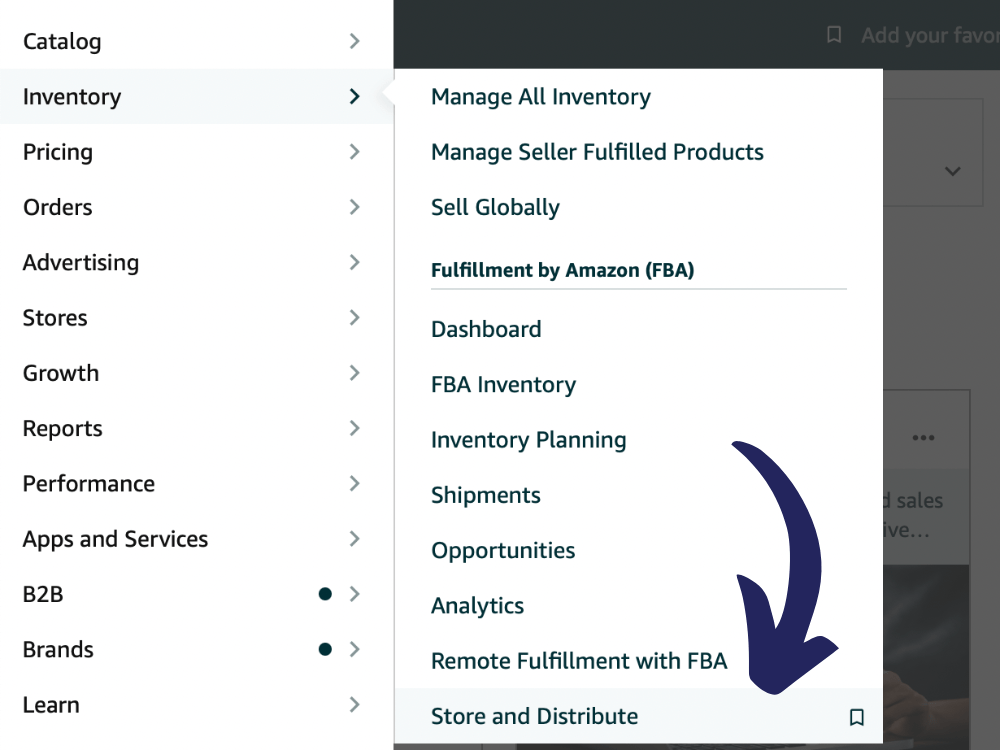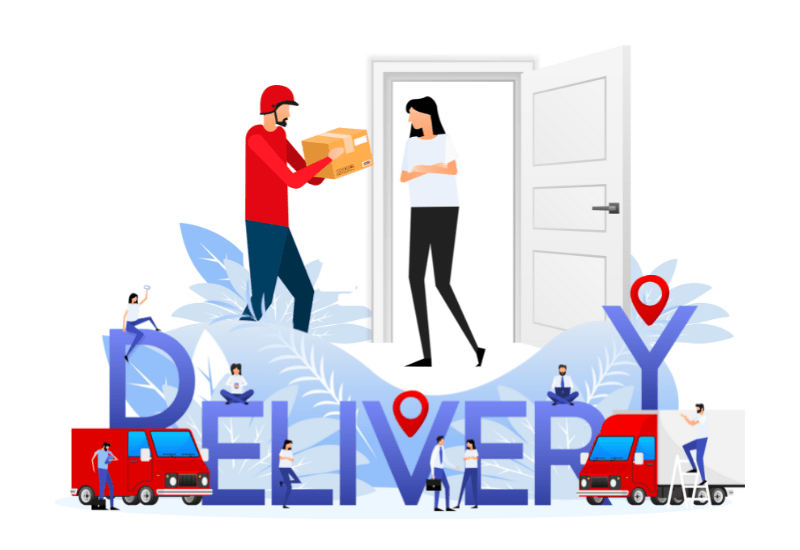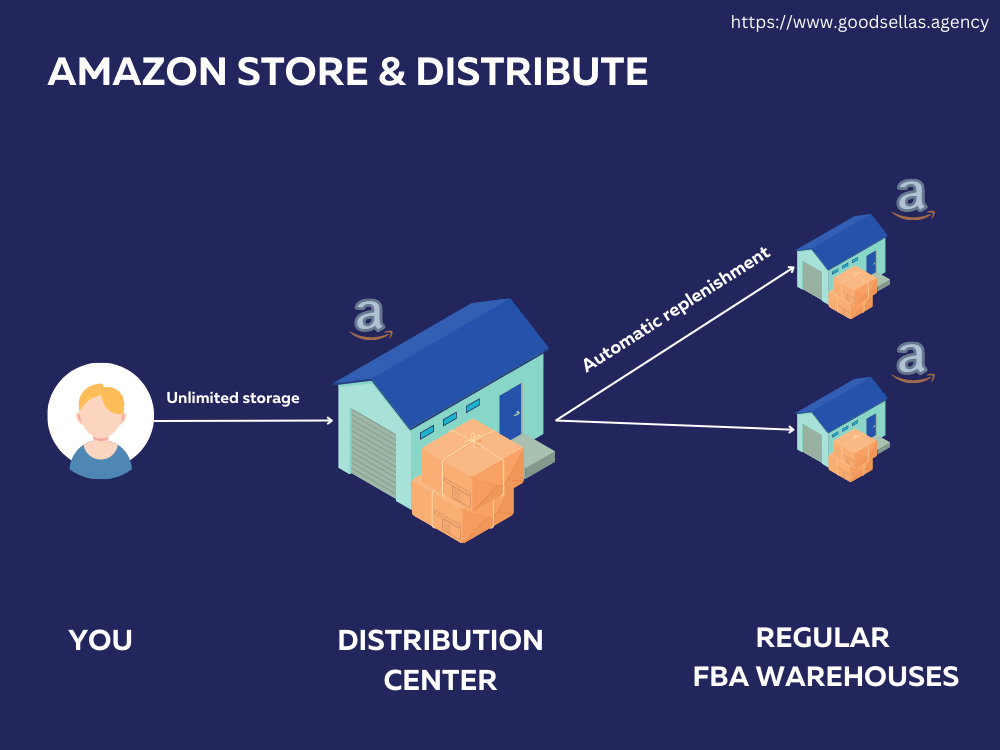It’s no secret that Amazon’s mission is dominate commerce. And that goes beyond just the shopping experience for customers. Amazon is attempting (and succeeding) to create a closed ecosystem that spans from sourcing all the way to the end consumer.
Just a few months ago, Amazon released one of the last missing pieces of the puzzle. The name of the piece? You guessed it: Amazon Store and Distribute.
If you’ve been wandering around your US seller central account in the past few weeks, you might have noticed a new feature under the ‘catalog‘ tab called ‘Store and Distribute‘.

Why Amazon launched Amazon Store & Distribute
On paper, Amazon Store and Distribute looks like a welcome game changer. If you’ve been moving some volume ever since Covid-19 made its first appearance, you’ll have noticed increased logistical challenges.
A lot of sellers suddenly found themselves being restricted from sending in their usual amounts of inventory. The explanation was that due to infections and social distancing, warehouses were at capacity. As a result, each seller was given a ‘storage allowance’ based on his or her IPI metrics.
This system was, and still is, hugely flawed. It makes inventory planning a huge headache and created a spiral of frustration for many sellers.
Low storage allowance forced FBA sellers to fulfil items themselves, or through a third party fulfilment centers. Often, these sellers found a third party service provider overnight. Third party fulfilment enters suddenly attracted a wave of new business. More than what they were accustomed to. As a result, they often performed poorly.
Other Amazon sellers used third party warehouses to store larger quantities of inventory. They would then ‘drip-feed’ their inventory to the Amazon warehouses, Sometimes in batches of a few hundred units at a time. Whatever little allowance the Amazon-lords allowed to you to have at any given time.
Most sellers used Amazon's 'Amazon Partnered Carrier' for this.
The ‘Amazon Partnered Carrier’ service is a pickup service organised by Amazon that picks up your inventory from your address or a third party warehouse and brings it to the FBA warehouses.
More often than not, the Amazon Partnered Carrier pickups were cancelled or horribly delayed. Those were frustrating times.
To make things worse, Amazon would then punish you for being out of stock. (Even though the delay was caused by their service). This punishment translated in a lower IPI, which in turn contracts your storage allowance even more.
Now, after 2-3 years of torment, Amazon released Store and Distribute. This program should in theory solve this major pain point. But, you guessed, it comes with a price tag. More on that later in the article.

How Amazon Store and Distribute works
What is Amazon Store and Distribute? This is how Amazon explains how their new feature works:
Amazon Warehousing and Distribution provides a simplified upstream bulk storage solution that empowers you to automatically and optimally position your inventory in Prime-ready fulfillment centers.
With this new solution, you will:
Attain visibility and control over inventory levels across your end-to-end supply chain
Only pay for the storage space that you use, without entering into complicated storage contracts
Enjoy automated replenishment and a 99% in-stock guarantee, so you can reduce time spent managing your inventory and focus on growing your business
Source (Amazon.com)
This probably won’t come as a massive surprise: The system ‘stores’ for you, and then ‘distributes’ for you.
In practice that means that you get to send all the inventory you need for, let’s say, 6 months, to the Amazon distribution center.
After that, the Amazon machine does the heavy lifting for you. If a SKU is running out of stock, Amazon’s distribution center will automatically anticipate a possible out of stock situation by sending your inventory to the most relevant warehouses.
The interface is almost identical to the regular ‘send to Amazon‘ interface, so it should be very easy to get started.

Does Amazon Store and Distribute work for all categories?
Amazon Store and Distribute does have some limitations. It does not welcome al products types.
These product types are excluded from Amazon Store and Distribute:
- Everything with an experiation date
- HAZMAT products
- Shoes
- Jewelry & watches
- High value products
- Amazon devices & gift cards
- All groceries
There also are some side restrictions. Cartons cannot be larger than 25 inches long x 25 inches wide x 36 inches high on any side and cannot weigh more than 50 pounds. Individual SKUs inside any carton can’t be larger than 18 inches long x 14 inches wide x 8 inches high and cannot weigh more than 20 pounds.
How much does Amazon Store and Distribute cost?
Amazon mentions three separate fees for Amazon Store and Distribute:
Upstream storage
For all of the merchandise you’ve shipped to the Amazon Warehousing and Distribution facility, fees are assessed once each month. Amazon charges for space used in cubic feet, and bases these rates on daily consumption. The month after they accrue, monthly storage fees will show up on your Seller Central account.
Processing fees
While your items are at the Amazon Warehousing and Distribution facility, processing fees will be used to cover all inbound and outbound handling tasks. Once your products leave the Amazon Warehousing and Distribution facility and are sent to the Amazon fulfillment network, processing fees will show up on your Seller Central account.
Transportation fees
For cases restocked to the Amazon fulfillment network from the Amazon Warehousing and Distribution center, transportation costs are calculated per cubic foot. Once your products have been delivered to the Amazon fulfillment network, transportation charges will show up on your Seller Central account.
The amazon rate card as per Amazon.com:
| Fee type | Current rate card (valid through July 31, 2022) | New rate card (effective August 1, 2022) |
|---|---|---|
| Storage fees | Non-holiday (Jan – Sep): $0.62 per cubic foot Holiday season (Oct – Dec): $1.20 per cubic foot | Non-holiday (Jan – Sep): $0.42 per cubic foot Holiday season (Oct – Dec): $0.80 per cubic foot |
| Processing fees | $3.20 per case | $2.00 per case |
| Transportation fees | $1.00 per cubic foot | $1.00 per cubic foot |
The full fees breakdown can be found on the Amazon website.
The big advantage of using Amazon Store and Distribute
The system is still in its infancy, so it’s too early to tell how smooth it works on a long enough timeline. The concept looks extremely convenient and it seems like the solution many sellers have been waiting for ever since strict storage limits have been implemented.
There are some obvious reasons to use it, such as automatic SKU fulfilment and just overall convenience. However, I want to highlight a secondary benefits.
You are able to get better pricing for inventory as you can purchase higher quantities up front.
With the world economy being so volatile, shipping costs or raw materials can suffer a 20% increase overnight. It makes a lot of sense to invest in your products that have a proven track record and purchase, let’s say, a years worth of supply. Armed with this strategy, you’ll be able to:
- Negotiate a better product price with your supplier
- Pay less / unit for freight due to higher volumes
- Stay in stock
- Improve your IPI score
- Decrease your headaches
- Make more profit overall
I seriously recommend you to stock up on your inventory. If cashflow is tight, check out our partner Viably: they can bankroll your business to purchase new inventory. They have some of the lowest rates on the market and their app is a breeze to work with.
The big downside of using Amazon Store and Distribute
We’ve never experienced ‘late stage capitalism‘ the way it is unfolding now. Giants like Amazon obtain more power day by day. The mantra ‘don’t put all your eggs in one basket’ becomes harder to practice as the end consumer starts buying eggs only from that one basket.
The past has proven that is scary to be at Amazon’s mercy. Experienced sellers know not to rely on any form of empathy and that the Amazon machine relies on algorithms and black and white decision-making.
Logistics is often still in hands of the seller anno 2022. That will change soon. Do we really want to give our last piece of control to Amazon?
What if we get flagged for a bogus HAZMAT claim and we now need to destroy a years worth of inventory to keep our Seller Account intact?
Supposing, Amazon loses a shipment as it often does, but now on a much larger scale?
Imagine, Amazon decides to punish us for a potential violation by holding our inventory in the distribution centers so our FBA inventory runs dry?
The future for eCommerce looks Orwellian.
However, convenient.



